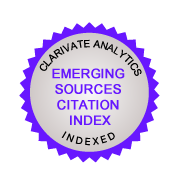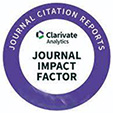Adsorption of Ni(II) Ion onto Calcined Eggshells: A Study of Equilibrium Adsorption Isotherm
Hans Kristianto(1*), Novitri Daulay(2), Arenst Andreas Arie(3)
(1) Department of Chemical Engineering, Faculty of Industrial Technology, Parahyangan Catholic University, Jl. Ciumbuleuit 94, Bandung 40141, Indonesia
(2) Department of Chemical Engineering, Faculty of Industrial Technology, Parahyangan Catholic University, Jl. Ciumbuleuit 94, Bandung 40141, Indonesia
(3) Department of Chemical Engineering, Faculty of Industrial Technology, Parahyangan Catholic University, Jl. Ciumbuleuit 94, Bandung 40141, Indonesia
(*) Corresponding Author
Abstract
Adsorption is one of the most effective and economical method to treat heavy metals in water. In this study, we utilize waste chicken eggshells as biosorbent to adsorb Ni(II). Furthermore we study the effect of eggshell calcination on its adsorption performance. The effect of calcination on the characteristic of eggshell was observed using Fourier Transform Infrared Spectroscopy (FTIR) and Scanning Electron Microscope-Energy Dispersive X-ray Spectroscopy (SEM-EDS). It could be observed that CaCO3 in eggshell was converted into CaO, and from SEM images the calcined eggshell became more porous than the uncalcined one. The effect of various parameters such as initial Ni(II) solution pH and initial Ni(II) concentration was investigated using batch adsorption experiments. The data obtained then fitted to Langmuir, Freundlich, Temkin, and Dubinin-Radushkevich isotherms. The best pH for Ni(II) adsorption was found to be 6. From Langmuir and Dubinin-Radushkevich, it was found that calcined eggshells gave 60 times higher maximum adsorption capacity then uncalcined one. This increase was possible due to more porous structure of calcined eggshells. The adsorption process was found to be exothermic and physisorption. This result was confirmed by the decrease of % removal with increase of temperature. Furthermore, Langmuir isotherm was found to be the best model, indicating adsorption of Ni(II) was monolayer adsorption on homogenous surface.
Keywords
Full Text:
Full Text PDFReferences
[1] Nagajyoti, P.C., Lee, K.D., and Sreekanth, T.V.M., 2010, Heavy metals, occurrence and toxicity for plants: A review, Environ. Chem. Lett., 8 (3), 199–216.
[2] Hunt, J.W., Anderson, B.S., Phillips, B.M., Tjeerdema, R.S., Puckett, H.M., Stephenson, M., Tucker, D.W., and Watson, D., 2002, Acute and chronic toxicity of nickel to marine organisms: Implications for water quality criteria, Environ. Toxicol. Chem., 21 (11), 2423–2430.
[3] Das, K.K., Das, S.N., and Dhundasi, S.A., 2008, Nickel, its adverse health effects & oxidative stress, Indian J. Med. Res., 128 (4), 412–425.
[4] The ministry of Environment, 2014, Peraturan Menteri Lingkungan Hidup Republik Indonesia Nomor 5 Tahun 2014 Tentang Baku Mutu Air Limbah, Jakarta.
[5] Fu, F., and Wang, Q., 2011, Removal of heavy metal ions from wastewaters: A review, J. Environ. Manage., 92 (3), 407–418.
[6] Oliveira, D.A., Benelli, P., and Amante, E.R., 2013, A literature review on adding value to solid residues: Egg shells, J. Cleaner Prod., 46, 42–47.
[7] Ministry of Agriculture Republic Indonesia, 2016, Produksi Telur Ayam Ras Petelur Menurut Provinsi, http://www.pertanian.go.id/ap_pages/mod/datanak, accessed on 4 October 2016.
[8] Schaafsma, A., van Doormaal, J.J., Muskiet, F.A.J., Hofstede, G.J.H., Pakan, I., and van der Veer, E., 2002, Positive effects of a chicken eggshell powder-enriched vitamin-mineral supplement on femoral neck bone mineral density in healthy late post-menopausal Dutch women, Br. J. Nutr., 87 (3), 267–275.
[9] Wei, Z., Xu, C., and Li, B., 2009, Application of waste eggshell as low-cost solid catalyst for biodiesel production, Bioresour. Technol., 100 (11), 2883–2885.
[10] Liao, D., Zheng, W., Li, X., Yang, Q., Yue, X., Guo, L., and Zeng, G., 2010, Removal of lead(II) from aqueous solutions using carbonate hydroxyapatite extracted from eggshell waste, J. Hazard. Mater., 177 (1-3), 126–130.
[11] Park, H.J., Jeong, S.W., Yang, J.K., Kim, B.G., and Lee, S.M., 2007, Removal of heavy metals using waste eggshell, J. Environ. Sci., 19 (12), 1436–1441.
[12] Flores-Cano, J.V., Leyva-Ramos, R., Mendoza-Barron, J., Guerrero-Coronado, R.M., Aragón-Piña, A., and Labrada-Delgado, G.J., 2013, Sorption mechanism of Cd(II) from water solution onto chicken eggshell, Appl. Surf. Sci., 276, 682–690.
[13] Kuh, S.E., and Kim, D.S., 2000, Removal characteristics of cadmium ion by waste egg shell, Environ. Technol., 21 (8), 883–890.
[14] Chojnacka, K., 2005, Biosorption of Cr(III) ions by eggshells, J. Hazard. Mater., 121 (1-3), 167–173.
[15] Daraei, H., Mittal, A., Noorisepehr, M., and Mittal, J., 2015, Separation of chromium from water samples using eggshell powder as a low-cost sorbent: kinetic and thermodynamic studies, Desalin. Water Treat., 53 (1), 214–220.
[16] Yeddou, N., and Bensmaili, A., 2007, Equilibrium and kinetic modeling of iron adsorption by eggshells in a batch system: effect of temperature, Desalination, 206 (1-3), 127–134.
[17] Pettinato, M., Chakraborty, S., Arafat, H.A., and Calabro, V., 2015, Eggshell: A green adsorbent for heavy metal removal in an MBR system, Ecotoxicol. Environ. Saf., 121, 57–62.
[18] Vijayaraghavan, K., Jegan, J., Palanivelu, K., and Velan, M., 2005, Removal and recovery of copper from aqueous solution by eggshell in a packed column, Miner. Eng., 18 (5), 545–547.
[19] Polat, A., and Aslan, S., 2014, Kinetic and isotherm study of copper adsorption from aqueous solution using waste eggshell, J. Environ. Eng. Landscape Manage., 22 (2), 132–140.
[20] Otun, J.A., Oke, I.A., Olarinoye, N.O., Adie, D.B., and Okuofu, C.A., 2006, Adsorption isotherms of Pb(II), Ni(II) and Cd(II) ions onto PES, J. Appl. Sci., 6 (11), 2368–2376.
[21] Aslan, S., Polat, A., and Topcu, U.S., 2015, Assessment of the adsorption kinetics, equilibrium and thermodynamics for the potential removal of Ni2+ from aqueous solution using waste eggshell, J. Environ. Eng. Landscape Manage., 23 (3), 221–229.
[22] Ince, M., 2014, Comparison of low-cost and eco-friendly adsorbent for adsorption of Ni(II), At. Spectrosc., 35 (5), 223–233.
[23] Haar, K.T., and Westerveld, W., 1948, The colorimetric determination of nickel as Ni(4) dimethylglyoxime, Recl. Trav. Chim. Pays-Bas, 67 (1), 71–81.
[24] Pornchai, T., Putkham, A.I., and Putkham, A., 2016, Effect of calcination time on physical and chemical properties of CaO- catalyst derived from industrial-eggshell wastes, J. Sci. Technol. MSU, 35 (6), 693–697.
[25] Kösea, T.E., and Kıvanç, B., 2011, Adsorption of phosphate from aqueous solutions using calcined waste eggshell, Chem. Eng. J., 178, 34–39.
[26] Marques Correia, L., Cecilia, J.A., Rodríguez-Castellón, E., Cavalcante,C.L.Jr., and Vieira, R.S., 2017, Relevance of the Physicochemical Properties of Calcined Quail Eggshell (CaO) as a Catalyst for Biodiesel Production, J. Chem., 2017, 5679512.
[27] Witoon, T., 2011, Characterization of calcium oxide derived from waste eggshell and its application as CO2 sorbent, Ceram. Int., 37 (8), 3291–3298.
[28] Galván-Ruiz, M., Hernández, J., Baños, L., Noriega-Montes, J., and Rodríguez-García, M.E., 2009, Characterization of calcium carbonate, calcium oxide, and calcium hydroxide as starting point to the improvement of lime for their use in construction, J. Mater. Civ. Eng., 21 (11), 694–698.
[29] Tan, Y.H., Abdullah, M.O., Nolasco-Hipolito, C., and Taufiq-Yap, Y.H., 2015, Waste ostrich- and chicken-eggshells as heterogeneous base catalyst for biodiesel production from used cooking oil: Catalyst characterization and biodiesel yield performance, Appl. Energy, 160, 58–70.
[30] Tangboriboon, N., Kunanuruksapong, R., and Sirivat, A., 2012, Preparation and properties of calcium oxide from eggshells via calcination, Mater. Sci., 30 (4), 313–322.
[31] Mohadi, R., Anggraini, K., Riyanti, F., and Lesbani, A., 2016, Preparation calcium oxide (CaO) from chicken eggshells, SJE, 1 (2), 32–35.
[32] Guru, P.S., and Dash, S., 2014, Sorption on eggshell waste–A review on ultrastructure, biomineralization and other applications, Adv. Colloid Interface Sci., 209, 49–67.
[33] Zhang, X., and Wang, X., 2015, Adsorption and Desorption of nickel(II) ions from aqueous solution by a lignocellulose/montmorillonite nanocomposite, PLoS One, 10 (2), e0117077.
[34] Hannachi, Y., Shapovalov, N.A., and Hannachi, A., 2010, Adsorption of Nickel from aqueous solution by the use of low-cost adsorbents, Korean J. Chem. Eng., 27 (1), 152–158.
[35] Limousin, G., Gaudet, J.P., Charlet, L., Szenknect, S., Barthès, V., and Krimissa, M., 2007, Sorption isotherms: A review on physical bases, modeling and measurement, Appl. Geochem., 22 (2), 249–275.
[36] Foo, K.Y., and Hameed, B.H., 2010, Insights into the modeling of adsorption isotherm systems, Chem. Eng. J., 156 (1), 2–10.
[37] Ayawei, N., Ebelegi, A.N., and Wankasi, D., 2017, Modelling and interpretation of adsorption isotherms, J. Chem., 2017, 3039817.
[38] Hameed, B.H., and Ahmad, A.A., 2009, Batch adsorption of methylene blue from aqueous solution by garlic peel, an agricultural waste biomass, J. Hazard. Mater., 164 (2-3), 870–875.
[39] Hamdaoui, O., and Naffrechoux, E., 2007, Modeling of adsorption isotherms of phenol and chlorophenols onto granular activated carbon Part I. Two-parameter models and equations allowing determination of thermodynamic parameters, J. Hazard. Mater., 147 (1-2), 381–394.
[40] Sampranpiboon, P., Charnkeitkong, P., and Feng, X., 2014, Equilibrium isotherm models for adsorption of zinc(II) ion from aqueous solution on pulp waste, WSEAS Trans. Environ. Dev., 10, 35–47.
[41] Hsieh, C.T., and Teng, H., 2000, Langmuir and Dubinin–Radushkevich analyses on equilibrium adsorption of activated carbon fabrics in aqueous solutions, J. Chem. Technol. Biotechnol., 75 (11), 1066–1072.
[42] Kumar, P.S., Ramalingam, S., Kirupha, S.D., Murugesan, A., Vidhyadevi, T., and Sivanesan, S., 2011, Adsorption behavior of nickel(II) onto cashew nutshell: Equilibrium, thermodynamics, kinetics, mechanism and process design, Chem. Eng. J., 167 (1), 122–131.
Article Metrics
Copyright (c) 2018 Indonesian Journal of Chemistry

This work is licensed under a Creative Commons Attribution-NonCommercial-NoDerivatives 4.0 International License.
Indonesian Journal of Chemistry (ISSN 1411-9420 /e-ISSN 2460-1578) - Chemistry Department, Universitas Gadjah Mada, Indonesia.












